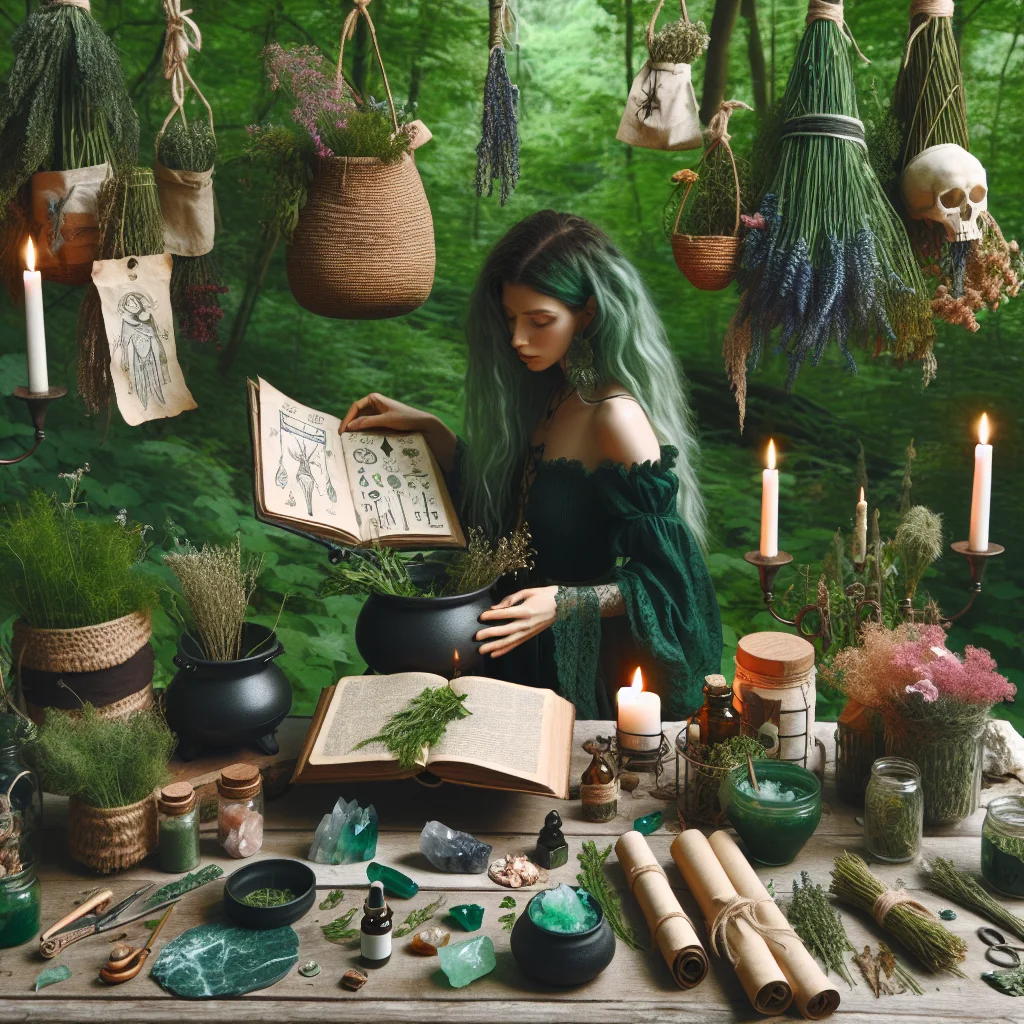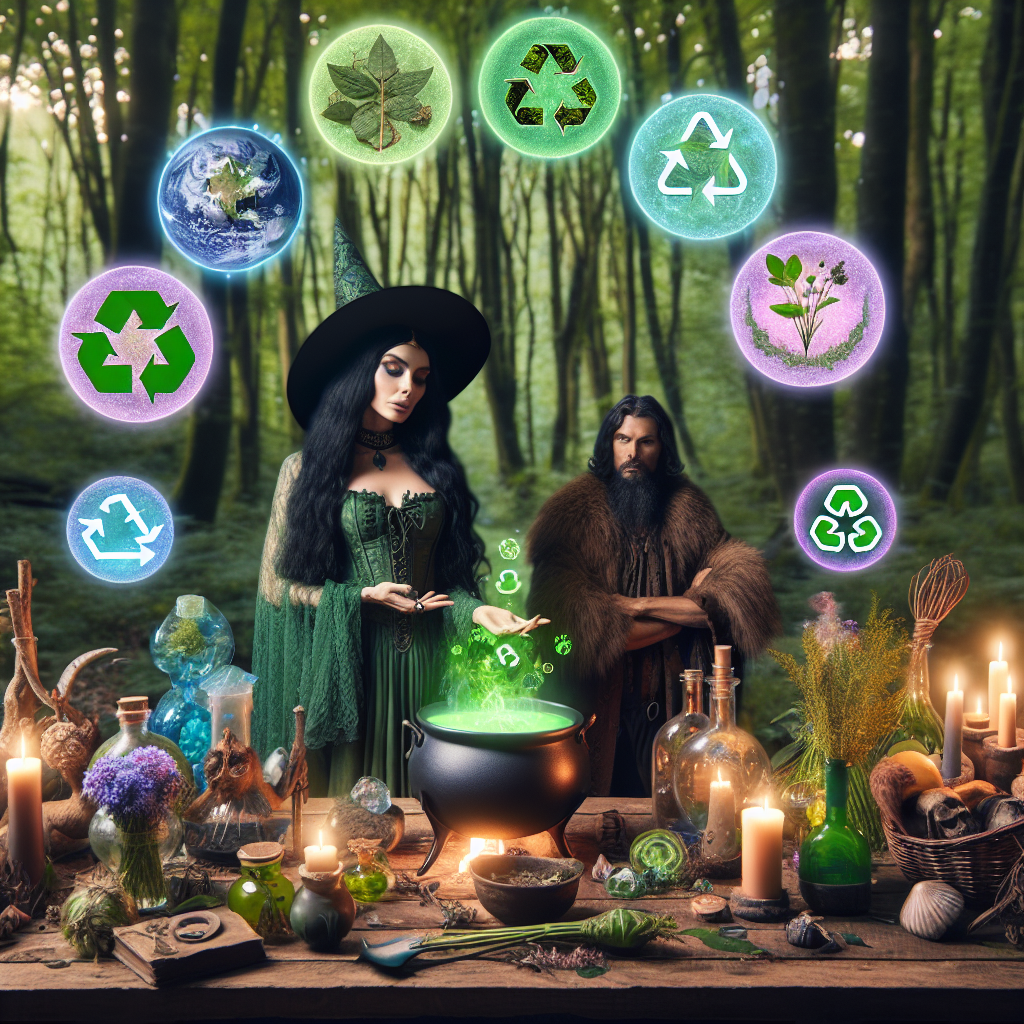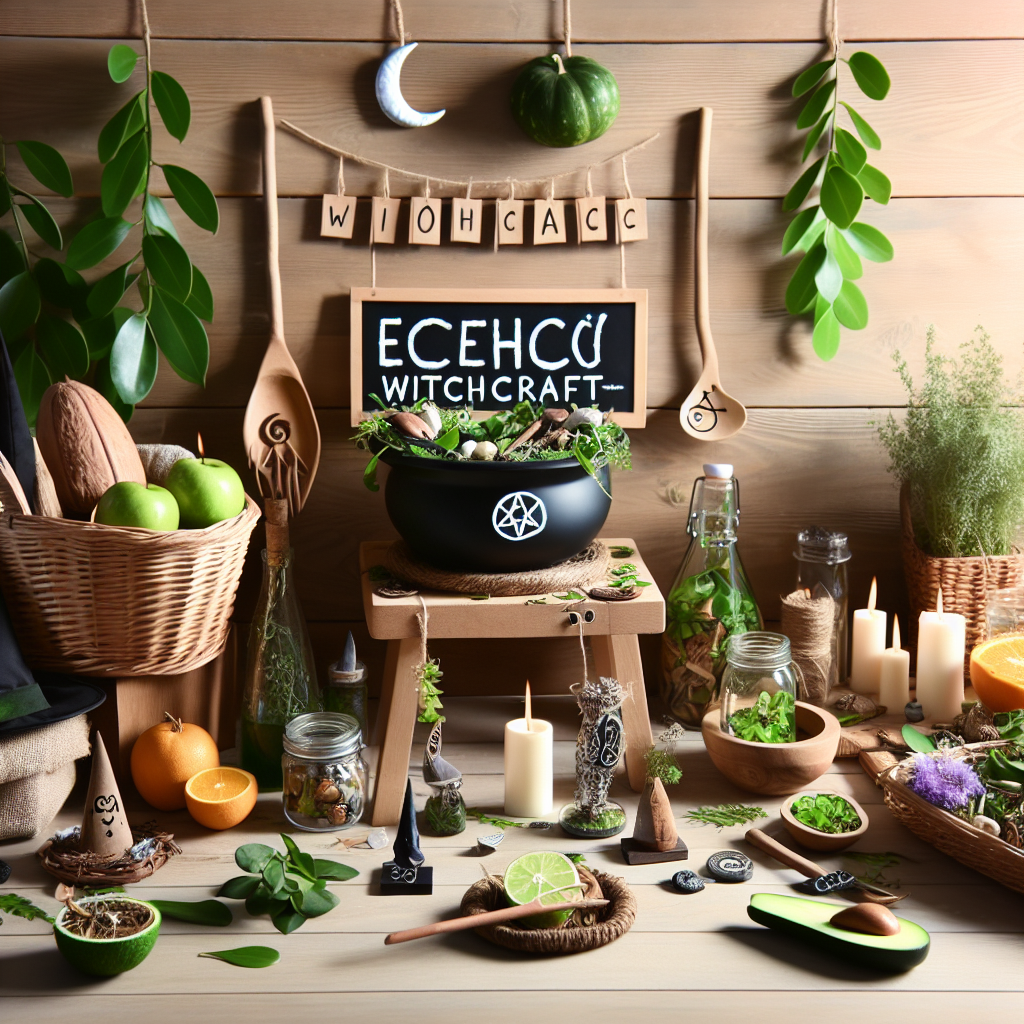As an Amazon Associate I earn from qualifying purchases.

Witchcraft has long been associated with nature and the use of natural materials, yet it's only in recent years that a specific focus on eco-friendly practices within the witchcraft community has emerged. This shift is a conscious response to the growing environmental concerns that face our planet. Historically, many witches have believed in living harmoniously with nature; however, the modern eco-friendly witchcraft movement, also known as “green witchcraft,” actively integrates sustainable and earth-friendly practices into its rituals and daily life, ensuring that their spiritual path leaves a positive, or at least neutral, impact on the Earth.
As a cornerstone of these practices, eco-friendly witches often source their ingredients and tools with great care, considering their origins and the processes through which they are made. Many opt for locally sourced herbs and plants, both wildcrafted and grown in their own gardens, which not only reduces transportation emissions but also allows for a connection with the local ecosystem. Additionally, where possible, green witches prefer to use renewable materials such as beeswax candles over paraffin, which is derived from petroleum, and natural stones or crystals obtained through ethical mining practices.
The use of digital spellbooks or ‘Book of Shadows’ has gained popularity among eco-friendly practitioners as a means to save paper. Likewise, there is an increasing trend toward the use of apps and online platforms for the sharing and recording of magical practices. Furthermore, eco-friendly witches may use technology to research the sustainability and ethics of the products they purchase, making informed choices to minimize negative environmental impact.
In ritual practice, the emphasis is often on minimalism and simplicity, utilizing items that can be found in nature or repurposed. This includes using seashells or stones as symbols on an altar instead of purchasing new items. The adoption of natural cycles, such as moon phases and seasonal changes, guides the timing of rituals and spells, aligning the practice with the rhythms of the earth without the use of consumable products.
An engaging statistic illuminates the shift towards eco-conscious spells and rituals: a survey conducted within the witchcraft community revealed that 78% of respondents had altered their practices in the past year for environmental reasons. This testament to the growing environmental awareness among practitioners underpins the expansion of eco-friendly witchcraft practices.
To further reduce their ecological footprint, witches practicing eco-friendly magic may also create their own tools and magical items from biodegradable and organic materials. The crafting of wands from fallen branches, making incense blends from garden-grown herbs, and creating reusable cloth bags for spell components are examples of such practices.
Water conservation is also an important element of eco-friendly witchcraft. Witches who work with water might use rainwater or natural bodies of water for rituals instead of tap water, and they are also mindful of minimizing water usage in their everyday lives as an extension of their magical practices.
The rise of eco-friendly witchcraft also sees practitioners working towards broader environmental change. This includes engaging in activism, such as participating in environmental clean-ups or advocating for policy changes. Moreover, it extends to community education, using their platforms to share knowledge on sustainability and conservation with both fellow witches and the wider community.
Part of the process involves actively working with and for the land spirits, which includes understanding local ecology, participating in conservation efforts, and sometimes performing healing rituals for the land that has been harmed by human activities. This deep respect for nature fosters a spiritual responsibility that goes beyond personal practice to a commitment to preserving and healing the environment at large.
**1. Use Biodegradable Materials:** Utilizing items that can naturally decompose is a core tenet of eco-friendly witchcraft. For spells and rituals, opt for materials like organic cotton, hemp, or beeswax instead of synthetics.
**2. Harvest Herbs Sustainably:** When sourcing herbs for any magical practice, ensure that you are either growing your own using organic methods or purchasing from sustainable harvesters to prevent overharvesting wild populations.
**3. Reuse and Recycle Altar Items:** Instead of buying new ritual items, repurpose and recycle what you already own. Old jars can hold herbs or homemade candles, and thrifted bowls can serve as offering vessels.
**4. Energy Conservation in Rituals:** Try to conduct rituals during daylight to use natural light, or use energy-efficient LED candles as an alternative to traditional candles.
**5. Natural Cleaning Products:** Cleanse your sacred space with natural products. Lemon juice, vinegar, and baking soda can replace harsh chemicals.
**6. Conserve Water:** During water-related rituals, be mindful of your usage. Collect rainwater for rituals, and if using tap water, ensure it's not wasted.
**7. Support Eco-Conscious Suppliers:** Purchase your tools and ingredients from suppliers who are committed to eco-friendly practices.
**8. Eco-Friendly Packaging:** When ordering supplies, look for items packed with recyclable or compostable materials instead of plastics.
**9. Digital Grimoires and Books of Shadows:** Create digital versions of your magic books to save on paper.
**10. Use Ethically Sourced Crystals:** Crystals can be part of many practices, but mining can be destructive. Source your crystals from ethical mines or consider alternatives that have less environmental impact.
**11. Sustainable Transport for Covens:** When meeting with other practitioners, carpool, or use public transport, to reduce carbon emissions.
**12. Plant-Based Rituals:** Incorporate plant-based offerings instead of animal products to lessen the ecological footprint of your practices.
**13. Moon Gardening:** Align your herb gardening with the phases of the moon to tap into natural rhythms and reduce the need for artificial growing aids.
**14. Eco-Friendly Altar Cloths:** Use altar cloths made from sustainable materials such as organic linen or recycled fibers.
**15. Incorporate Wildlife Conservation:** Work spells for the protection and conservation of local wildlife and their natural habitats.
**16. Non-Toxic Incense:** Choose incense made with natural ingredients instead of synthetic fragrances to avoid releasing harmful chemicals into the air.
**17. Solar-Charged Crystals and Tools:** Charge your magical tools with sunlight to incorporate eco-friendly energy practices into your craft.
**18. Mindful Foraging:** If collecting items from nature, do so mindfully and with respect, taking only what you need and leaving no trace.
**19. Recycled Paper for Spells and Sigils:** Use recycled or sustainably sourced paper when writing down spells, intentions, or sigils.
**20. Hold Outdoor Rituals:** Embrace the elements by holding rituals outdoors, minimizing energy consumption and connecting with nature.
**21. Live Plant Offerings:** Instead of cut flowers, use live plants as offerings, which can later be planted to continue the cycle of growth.
**22. Support Green Charities and Organizations:** As part of your practice, donate to charities that support environmental causes or take part in eco-friendly initiatives and education.
Adopting these eco-friendly witchcraft practices ensures that the spiritual path followed is also one that honors and respects the natural world. A 2020 study by Pew Research Center found that 9% of Americans say they regularly participate in practices typical of “New Age” spirituality, including elements such as energy healing and crystals, which partially overlaps with eco-friendly witchcraft practices. This percentage reflects a growing interest in integrating spirituality with environmental consciousness, underscoring the relevance of sustainable measures in the spiritual community.
“`html
Frequently Asked Questions
1. What are eco-friendly witchcraft practices?
Eco-friendly witchcraft practices are rituals and habits that minimize environmental impact and focus on sustainability. They involve using natural materials, ethically sourced items, and incorporating environmental conservation into the craft.
2. Why should I consider eco-friendly alternatives in my witchcraft?
Considering eco-friendly alternatives is important for protecting the environment, minimizing harm to ecosystems, and aligning your practice with the principles of honoring and preserving nature.
3. Can I still perform effective spells with eco-friendly materials?
Yes, spells can be just as effective with eco-friendly materials. The power of a spell relies more on your intention and energy rather than the specific materials used.
4. How can I ensure the herbs I use are sustainably sourced?
You can ensure herbs are sustainably sourced by purchasing from reputable suppliers who prioritize ethical practices, by growing your own, or by foraging responsibly with knowledge of local ecosystems.
5. Are there any eco-friendly alternatives to incense and smoke cleansing?
Eco-friendly alternatives to incense and smoke cleansing include using a spray made of essential oils and water, sound cleansing with bells or singing bowls, or using ethically sourced palo santo and sage.
6. Is it possible to reduce waste in my witchcraft practice?
Yes, you can reduce waste by reusing materials, choosing biodegradable options, and avoiding single-use items in your practice.
7. What can I use instead of animal products in my spells?
Instead of animal products, you can use plant-based or synthetic alternatives that correspond with your spell's intention, such as herbs, stones, or man-made symbols.
8. How do I dispose of spell remnants in an eco-friendly way?
Dispose of spell remnants by burying biodegradable items, recycling materials when possible, or repurposing items for future use.
9. Are there digital resources for learning more about eco-friendly witchcraft?
Yes, there are many digital resources including blogs, forums, ebooks, and social media groups dedicated to sharing information about eco-friendly witchcraft practices.
10. Can I still follow traditional witchcraft paths while being eco-friendly?
Yes, you can follow traditional witchcraft paths while adopting eco-friendly practices. Many traditional paths emphasize a connection with nature, which aligns with eco-friendly principles.
“`

Conclusion
Embracing eco-friendly witchcraft practices is an essential step towards aligning spiritual work with environmental stewardship. Throughout the discussed practices, key themes emerge such as the importance of sourcing materials sustainably, minimizing waste, and honoring the natural world. These practices encourage the use of locally harvested herbs, crystals obtained from ethical sources, and tools made from natural, biodegradable materials. By advocating for rituals that conserve energy, such as using natural light instead of candles or incorporating living plants into spellwork, eco-conscious witches not only reduce their carbon footprint but also strengthen their connection to the Earth.
The insights gained highlight a transformative approach to witchcraft that fosters a symbiotic relationship with nature. By incorporating methods like composting spell remnants, creating a wildlife-friendly garden, and utilizing digital resources to avoid paper waste, practitioners demonstrate a conscious effort to protect the planet. These eco-friendly techniques not only empower individuals in their personal magical endeavors but also contribute to a collective ecological balance. In realizing that the health of their craft is intrinsically linked to the health of the environment, witches who adopt these green practices play a pivotal role in the ongoing narrative of Earth-centered spirituality and sustainability.
Amazon and the Amazon logo are trademarks of Amazon.com, Inc, or its affiliates.


